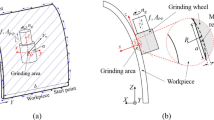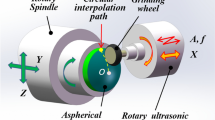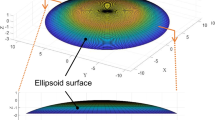Abstract
Zirconia ceramics have been used in the field of smartphone manufacturing, especially for the phone shells. To improve the machining efficiency and simultaneously obtain a mirror-surface quality on the curved surface made by zirconia ceramics, the tangential ultrasonic-assisted grinding (TUAG) was proposed, in which the ultrasonic vibrations of the grinding wheel are always in the direction tangential to the work surface at the grinding point. To reveal the fundamental grinding characteristics of the TUAG on the zirconia ceramic curved surface, the processing principle and according experimental setups were given out at first. The effects of the proposed method on the surface morphology and surface roughness were investigated experimentally and analyzed numerically under different process parameters for plane workpieces. Finally, a curved surface was successfully processed by the novel method with the optimized experimental conditions. The obtained results demonstrated that (1) typical sinusoidal cutting traces appeared on the work surface, which implied that the surface morphology was affected significantly by the ultrasonic vibrations; (2) the surface roughness was distinctly affected by the amplitude of the grinding wheel, and a higher efficiency was attained on the surface quality enhancement when the larger amplitude was applied, e.g., Ra was reduced by 58.3% when an amplitude of Ap–p = 4.66 μm was imposed; and (3) the Ra value in the direction vertical to the wheel feed direction on the curved surface decreased to 39.5 nm, implying that a mirror curved surface can be obtained by TUAG with the appropriate process conditions.
















Similar content being viewed by others
Data availability
The authors confirm that all data generated or analyzed and materials during this study are included in this article.
References
Wdowik R, Porzycki J, Magdziak M (2017) Measurements of surface texture parameters after ultrasonic assisted and conventional grinding of ZrO2 based ceramic material characterized by different states of sintering. Procedia CIRP 62:293–298
Jain AK, Pandey PM, Narasaiah K (2018) Effect of tool design parameters study in micro rotary ultrasonic machining process. Int J Adv Manuf Technol 98:1267–1285. https://doi.org/10.1007/s00170-018-2239-8
Yang Z, Zhu L, Lin B (2019) The grinding force modeling and experimental study of ZrO2 ceramic materials in ultrasonic vibration assisted grinding. Ceram Int 45:8873–8889. https://doi.org/10.1016/j.ceramint.2019.01.216
Yonggai H, Jiugen T, Jihong LU (2014) The current research status of zirconia ceramics grinding. China Ceram 50(9):6–9
Lv D, Huang Y, Tang Y, Wang H (2013) Relationship between subsurface damage and surface roughness of glass bk7 in rotary ultrasonic machining and conventional grinding processes. Int J Adv Manuf Technol 67(1–4):613–622. https://doi.org/10.1007/s00170-012-4509-1
Lauwers B (2011) Surface integrity in hybrid machining processes. Procedia Eng 19:241–251. https://doi.org/10.1016/j.proeng.2011.11.107
Brecher C, Schug R, Weber A (2010) New systematic and time-saving procedure to design cup grinding wheels for the application of ultrasonic-assisted grinding. Int J Adv Manuf Technol 47(1-4):153–159. https://doi.org/10.1007/s00170-009-2204-7
Li ZC, Jiao Y, Deines TW (2005) Rotary ultrasonic machining of ceramic matrix composites: feasibility study and designed experiments. Int J Mach Tool Manu 45(12-13):1402–1411. https://doi.org/10.1016/j.ijmachtools.2005.01.034
Yue Z, Huang C, Zhu H (2014) Material removal analysis in the radial-mode abrasive waterjet turning of ceramic materials. Int J Abras Technol 6(4):298–313. https://doi.org/10.1504/IJAT.2014.065830
Kizaki T, Ogasahara T, Sugita N, Mitsuishi M (2014) Ultraviolet-laser-assisted precision cutting of yttria-stabilized tetragonal zirconia polycrystal. J Mater Process Technol 214(2):267–275. https://doi.org/10.1016/j.jmatprotec.2013.09.015
Guo YF, Bai JC, Deng GQ (2007) High speed wire electrical discharge machining (HS-WEDM) phenomena of insulating Si3N4 ceramics with assisting electrode. Key Eng Mater 339:281–285. https://doi.org/10.4028/www.scientific.net/KEM.339.281
Sabur A, Ali MY, Maleque MA (2013) Investigation of material removal characteristics in EDM of nonconductive ZrO2 ceramic. Procedia Eng 56(3):696–701. https://doi.org/10.1016/j.proeng.2013.03.180
Kizaki T, Ito Y, Tanabe S (2016) Laser-assisted machining of zirconia ceramics using a diamond bur. Procedia Cirp 42:497–502. https://doi.org/10.1016/j.procir.2016.02.239
Marinescu ID (Ed.) (2006) Handbook of advanced ceramics machining. CRC Press, Boca Raton
Inasaki I, Nakayama K (1986) High-efficiency grinding of advanced ceramics. CIRP Ann Manuf Technol 35(1):211–214. https://doi.org/10.1016/S0007-8506(07)61872-1
Kitajima K, Cai GQ, Kurnagai N (1992) Study on mechanism of ceramics grinding. CIRP Ann 41(1):367–371. https://doi.org/10.1016/S0007-8506(07)61224-4
Inasaki I (1988) Speed-stroke grinding of advanced ceramics. CIRP Ann Manuf Technol 37(1):299–302. https://doi.org/10.1016/S0007-8506(07)61640-0
Shih AJ, McSpadden SB, Morris TO, Grant MB, Yonushonis TM (2000) High speed and high material removal rate grinding of ceramics using the vitreous bond CBN wheel. Mach Sci Technol 4(1):43–58. https://doi.org/10.1080/10940340008945699
Denkena B, Friemuth T, Reichstein M (2003) Potentials of different process kinematics in micro grinding. CIRP Ann Manuf Technol 52(1):463–466. https://doi.org/10.1016/S0007-8506(07)60626-X
Azarhoushang B, Tawakoli T (2011) Development of a novel ultrasonic unit for grinding of ceramic matrix composites. Int J Adv Manuf Technol 57(9-12):945. https://doi.org/10.1007/s00170-011-3347-x
Zahedi A, Tawakoli T, Azarhoushang B (2015) Picosecond laser treatment of metal-bonded CBN and diamond superabrasive surfaces. Int J Adv Manuf Technol 76(5-8):1479–1491. https://doi.org/10.1007/s00170-014-6383-5
Zahedi A, Tawakoli T, Akbari J (2015) Energy aspects and workpiece surface characteristics in ultrasonic-assisted cylindrical grinding of alumina-zirconia ceramics. Int J Mach Tools Manuf 90:16–28. https://doi.org/10.1016/j.ijmachtools.2014.12.002
Ahn JH, Lim HS, Son SM (2001) Characteristics of micro-machining using two-dimensional tool vibration. Int J Precis Eng Manuf 2(3):41–46
Lauwers B, Bleicher F, Ten Haaf P (2010) Investigation of the process-material interaction in ultrasonic assisted grinding of ZrO2 based ceramic materials. Proc. of 4th CIRP Int. Conf. High Performance Cutting 2010 2:59–64. https://lirias.kuleuven.be/handle/123456789/282040
Pei Z, Ferreira P, Kapoor S, Haselkorn M (1995) Rotary ultrasonic machining for face milling of ceramics. Int J Mach Tools Manuf 35(7):1033–1046. https://doi.org/10.1016/0890-6955(94)00100-X
Ke XL, Guo YB, Wang ZZ (2013) Research on precision truing and accuracy evaluation technique for arc diamond truer. J Xiamen Univ (Natural Science) 52(06):797–801
Mitsuyoshi N, Yongbo W, Tsunemoto K (2007) Investigation of internal ultrasonically assisted grinding of small holes: effect of ultrasonic vibration in truing and dressing of small CBN grinding wheel. J Mech Sci Technol 21:1605–1611. https://doi.org/10.1007/BF03177382
Wang Y, Lin B, Zhang X (2014) Research on the system matching model in ultrasonic vibration-assisted grinding. Int J Adv Manuf Technol 70(1-4):449–458. https://doi.org/10.1007/s00170-013-5269-2
Zhao B, Wu Y, Liu CS (2006) The study on ductile removal mechanisms of ultrasonic vibration grinding nano-ZrO2 ceramics. Key Eng Mater 304-305:171–175. https://doi.org/10.4028/www.scientific.net/KEM.304-305.171
Cao JG, Wu YB, Lu D (2014) Material removal behavior in ultrasonic-assisted scratching of SiC ceramics with a single diamond tool. Int J Mach Tool Manu 79:49–61. https://doi.org/10.1016/j.ijmachtools.2014.02.002
Huang W, Yu D, Zhang X, Zhang M, Chen D (2018) Ductile-regime machining model for ultrasonic elliptical vibration cutting of brittle materials. J Manuf Process 36:68–76. https://doi.org/10.1016/j.jmapro.2018.09.029
Cao J, Nie M, Liu Y (2018) Ductile-brittle transition behavior in the ultrasonic vibration-assisted internal grinding of silicon carbide ceramics. Int J Adv Manuf Technol 96:3251–3262. https://doi.org/10.1007/s00170-018-1715-5
Acknowledgments
This work was financially supported by National Nature Science Foundation of China (Grant No. 51975269), Shenzhen Science and Technology Program (Grant No. KQTD20170810110250357) and Shenzhen Knowledge Innovation Plan (Grant No. JCYJ20180504165815601). A special thanks goes to Core Research Facilities of Southern University of Science and Technology.
Funding
National Nature Science Foundation of China (Grant No. 51975269), Shenzhen Science and Technology Program (Grant No. KQTD20170810110250357) and Shenzhen Knowledge Innovation Plan (Grant No. JCYJ20180504165815601).
Author information
Authors and Affiliations
Contributions
The corresponding author Yongbo Wu has guided the paper writing and contributed to data discussion and article revision. Jiaping Qiao was responsible for writing, developing the experimental designs and measurements, and analyzing experimental results. Ming Feng assisted in data processing and paper revision. Yang Li and Sisi Li were responsible for simulating the cutting trace of abrasive grain and improving the test jigs. Jiang Zeng took part in ensuring the experimental environment and preparing workpieces.
Corresponding author
Ethics declarations
Conflict of interest
The authors declare that they have no conflict of interest.
Ethical approval
Not applicable
Consent to participate
Not applicable
Consent to publish
Not applicable
Additional information
Publisher’s note
Springer Nature remains neutral with regard to jurisdictional claims in published maps and institutional affiliations.
Rights and permissions
About this article
Cite this article
Qiao, J., Feng, M., Li, Y. et al. A study on tangential ultrasonic-assisted mirror grinding of zirconia ceramic curved surfaces. Int J Adv Manuf Technol 112, 2837–2851 (2021). https://doi.org/10.1007/s00170-020-06512-2
Received:
Accepted:
Published:
Issue Date:
DOI: https://doi.org/10.1007/s00170-020-06512-2




